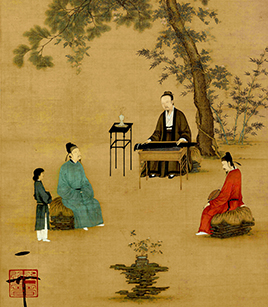China’s ritual and music culture

FILE PHOTO: A detail of “Listening to the Qin Zither” by Emperor Huizong of Song
The li-yue culture, or the ritual and music culture, is an important part of traditional Chinese culture. Li, often translated as rites, is a general term for social norms that regulate an individual’s relationship with the others in Chinese culture. According to Book of Rites, “Rites are the basis for determining proper human relations, clarifying ambiguities, differentiating between things, and telling right from wrong.” By setting various regulations about ritual vessels, rituals, and systems, rites define an individual’s social status and corresponding duty and power, thereby differentiating between people in a community in terms of age, kinship, and position.
Yue, or music, is often mentioned together with li. In contrast to rules and rites, music touches the emotions and thus can affect human behavior. The Confucian classic Xunzi records that “Nothing can replace music for creating social harmony, and nothing can replace rites for determining ethical social differences. Music brings people together in harmony; rites establish roles and relationships. Together they direct human morality.” The ancients believed that music has the power of making the listener calm and measured so as to consciously behave in accordance with social norms, and thus engage harmoniously with others. Therefore, music is often associated with other forms of ceremonial rituals as one important way of maintaining proper human relations and encouraging better social practices.
The Zhou (c. 1046–256 BCE) was the first dynasty to establish rules of li and yue [music that accompanied ritual ceremonies], so as to reinforce and stabilize its strict social hierarchy. Every person of each grade in the hierarchy enjoyed the type of rites and music assigned to his or her particular grade. The ritual and music system laid a solid foundation for the unified culture fixed by the Qin and Han empires. It still has strong vitality after thousands of years’ influence in the Chinese civilization history.
Edited by REN GUANHONG

 PRINT
PRINT CLOSE
CLOSE